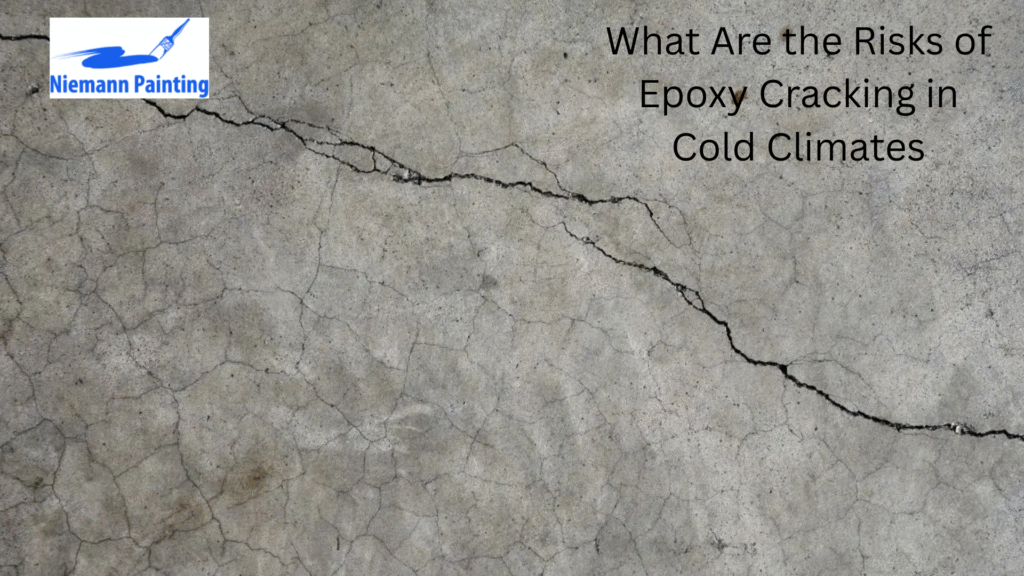Epoxy floors are common in many homes, shops and businesses as they’re used to maintain and look good. That said, people in cold-weather cities with severe winters ask the question: Can you put epoxy flooring outside, what are some of the issues with outdoor epoxy flooring and why? In this blog, we will discuss the effect that cold weather can have on your floor epoxy and what threats homeowners and business owners should look out for.
Cold weather is just one of the many variables that contribute to temperature change, moisture and improper installation which affect how your epoxy floor performs. You thought you were doing the right thing for your floors when you established. Rule in your home to keep outside dirt and damage to your sparkling wood and tile flooring. Let’s explore those risks a little more closely and their respective solutions to keep your epoxy flooring strong regardless of the weather.
Why Does Cold Weather Affect Epoxy Flooring?
The science behind epoxy floors are formulated using a combination of resins and hardeners that react to create a tough, rigid surface. Although this ensures that epoxy floors are almost scratch-proof, stain-proof, and crack resistant, cold temperatures can be a different story for epoxy. Below are some main reasons that epoxy floor coatings suffer in cold weather:
1. Temperature Sensitivity of Epoxy Resin
Epoxy is a thermosetting resin, so although all epoxy has delicate thermal characteristics, this does not mean it is the only type that can be used for filling holes. In cool temperatures, the curing of your epoxy flooring can stall or stop completely when applied in freezing weather. This may not allow the epoxy to cure properly on the floor, leading to weak spots or cracking later.
The majority of epoxy flooring is installed at temperatures ranging from 50F /10C to 90F/32C. Should the temperature fall outside of this range, then the resin will not have a chance to cure and you will be left with an uneven, crumbly surface. If at any time the resin were to get really stiff, as it could have in freezing temperatures, it would not settle properly and instead crack.
2. Moisture and Condensation
The colder the air gets, the more moisture we tend to bring inside, particularly in spaces like garages or basements, where cold air meets warm and moist indoor air. During humid conditions, moisture can develop underneath the surface of an epoxy floor and cause delamination to occur. The moisture can lead to the epoxy wrapping or bubbling over time.
Temperature variation day and night can also create condensation which may result in moisture damage under the floor coat. This can be particularly problematic on newly cured surfaces if it has been recently applied and doesn’t have enough time to cure.
3. Expansion and Contraction
Epoxy surfaces, along with most other materials, move as temperatures rise and fall. In cooler parts of the world, this can cause undue stress on the floor if it was not laid with the correct expansion joints or if there were premature curing issues (from conditions too cold for your Resin). This contraction of epoxy can cause cracking and damage over time, which would require costly repairs.
What Are the Risks of Epoxy Cracking in Cold Climates?

Before installing epoxy in cold temperatures, there are certain liabilities you should be aware of. First let’s explore some of the risks associated with using epoxy in cold climates and what they could mean for your flooring over time:
1. Epoxy Cracking Due to Improper Curing
In cold weather, one of the biggest hazards is an inadequate curing of the epoxy resin. When the temperature is lower than the epoxy’s prescribed range, you could risk your floor not curing as it should, resulting in a more brittle surface that could crack.
In the cooler months curing takes longer and if a slab does not cure properly, it will have very unattractive cracks that appear on its surface-especially in those areas where vehicle or heavy equipment traffic are present. Cosmetic cracking or structural damage caused by insufficient curing is most often the reason for uncovered cracks, but it can actually become a bigger problem later on.
2. Poor Adhesion
Cold can be bad for the epoxy sticking to the surface it’s laid upon, too. If the floor is too cold when applied, the epoxy may fail to adhere appropriately with its substrate — whether that’s concrete or another material. This weak adhesion reduces the likelihood of peeling or flaking especially under demanding conditions such as heavy foot traffic or abrasive equipment use.
When the floor is not warm enough, and if it doesn’t meet that minimum requirement for temperature when you apply epoxy, then adhesion will suffer: the bond will break as the epoxy lifts and becomes cracked over time. This is a common problem in locations like garages or basements where the floor is subject to extremes of temperature.
3. Moisture-Related Issues
It’s worth repeating how important moisture is when you’re dressing to enter the cold. Moisture is more likely to condense as the temperature goes lower. If water gets beneath the epoxy, it can loosen the grip and lead to epoxy lifting or bubbling. Furthermore, moisture may get trapped and result in the growth of mold and mildew which can cause even more damage to the floor.
Before application, if moisture is either sealed underneath the epoxy or remains on mechanical equipment, it can damage the flooring and create cracks, peels, or bubbles in the coating. This becomes of particular concern in areas like Minnesota, where winter temperatures are low and relative humidity is high at some times of the year.
4. Long-Term Durability
In cold weather, the lifespan of epoxy flooring decreases compared to warmer areas. Even if the flooring’s able to survive winter in its first year, continued exposure of it expanding and contracting can end up causing that material to wear out. The epoxy filler can get brittle over time which causes them to crack, particularly where the fork trucks drive.
How to Protect Epoxy Flooring in Cold Climates
If you are installing or have installed epoxy flooring in cold weather climates, there are a few strategies to protect the surface from suffering damage during cold months. Here are some helpful tips:
1. Proper Temperature for Application
Be sure to coat your flooring with epoxy between the recommended temperature range. This is to allow for adequate curing and bonding. In an ideal world, have your epoxy sealer applied when the temperature is between 50°F and 90°F as it can be prone to cracking if too cold. If the weather isn’t cooperating, waiting may be the best option rather than having some improper curing on your hands.
2. Use Cold-Weather Epoxy
There are epoxy resins available that were formulated to be utilized during cold weather. These compositions can be robust at lower temperatures and more crack/cure resistant. If you are using the epoxy in a cold climate, think about investing in some cold weather epoxy to minimize the risks of harm.
3. Ensure Proper Surface Preparation
The surface should be dry and free of water prior to applying epoxy. 4.) If the surface is cold, heat with a hair-dryer or wait 24 hours allowing natural room temperature to warm up before application. This will allow the epoxy to adhere better and minimize any potential problems with moisture.
4. Install Expansion Joints
In some cases, expansion joints in flatwork (such as drives or garages) may help to alleviate cracking due to shrinkage and/or temperature. These joints provide for expansion and contraction of the floor, without stressing the epoxy. Allowing a little give in the surface also helps to prevent it from cracking and other damage over time.
5. Regular Maintenance
Always check for potential damage on your epoxy floor such as chips and/or peeling. This proactive identification of issues can help prevent additional harm. If you see any drywall cracks developing do to take care of it first off so that the issue does not become Miss Ora worse down the line.
FAQs
Yes, epoxy floor coatings will not cure correctly when in an installation with freezing temperatures which can cause the coating to crack and not bond to itself or substrate.
Epoxy flooring should be applied between 50°F and 90°F. If it’s colder — which, let’s face it, does often happen during the winter months — use a cold-weather epoxy or wait for the temperatures to go back up.
Prepare the surface well, use cold-weather epoxy and include expansion joints to prevent cracking or other forms of damage.
If moisture is trapped beneath the epoxy coating, it can make it peel, bubble, or crack. It can also promote the growth of mold and mildew.
With a proper wear coat and some good hardeners, overall I would agree that Epoxy floors can be long lasting in cold regions with the correct type of application and material. But it might require extra upkeep in extreme cold.
Conclusion
Yes, harsh weather can impact epoxy flooring and create problems including cracks, peeling, and water damage. That said, where they take care to use the right primers and install it as recommended, fear-inducing epoxy floors for garages or basements don’t have to be. And be sure to use cold-weather epoxy, install the flooring at the best temperature and care for your floors year-round so they look great all winter long.
To read further on how to take care of your floors as well as the services, visit Niemann Painting. We’re here to assist you in advancing the most durable and longest lasting floor on your home or business.

